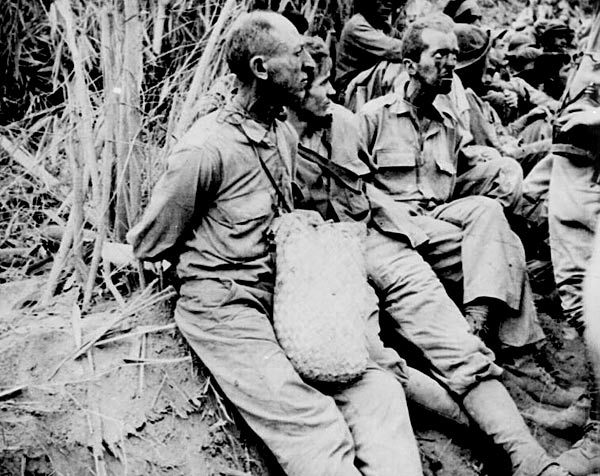Bataan Death March
Page 2
After reaching Balanga, it became obvious to General Kawane that his trucks could not carry more than half of the prisoners to the rail center at San Fernando. Since most of the other vehicles the Japanese had brought to the Philippines were either in repair or being used for the Battle of Corregidor, those who could not get a ride were forced to continue marching for more than 30 miles on completely unshaded roads that were sometimes made of asphalt. The thick dust swirling in the air would make it difficult for the prisoners to see and breathe while those who were walking barefoot had their feet burned on the molten asphalt. Men who refused to abandon their belongings were the first to fall. The last nine miles of the march from the town of Lubao to San Fernando were among the hardest the men would ever walk.
Those who were able to reach San Fernando alive were then locked into makeshift prisons where they were finally able to receive some level of proper and adequate medical care, food, and rest. Soon after this, however, the prisoners were jammed into freight trains that took them to Capas. Vomiting was frequent during the ride as some were even crammed or suffocated to death. After the three hour trip, which included very few stops, the prisoners then marched the 8 mile road to Camp O'Donnell.
Through the duration of nine days, a majority of the disease and grief stricken American and Filipino prisoners were forced to march as much as two-thirds of the 90 miles that separated Bataan from Camp O'Donnell. Those few who were lucky enough to travel to San Fernando on trucks still had to endure more than 25 miles of marching. Prisoners were beaten randomly and were often denied the food and water they were promised. Those who fell behind were usually executed or left to die; the sides of the roads became littered with dead bodies and those begging for help. A number of prisoners were further diminished by malaria, heat, dehydration, and dysentery. It should be noted, however, that many of the soldiers who accompanied the prisoners of war were not only Japanese, but Korean. Since they were not trusted by the Japanese to fight on the battlefield, most Koreans in the Japanese army were forbidden to participate in combat roles and delegated to such service duties as guarding prisoners. As one prisoner noted, "The Korean guards were the most abusive... the Koreans were anxious to get blood on their bayonets; and then they thought they were veterans."
After the Bataan Death March, approximately 54,000 of the 72,000 prisoners reached their destination. The death toll of the march is difficult to assess as thousands of captives were able to escape from their guards. In some instances, prisoners were even released by their Japanese counterparts. Out of fear that the prisoners would be mistreated, Colonel Takeo Imai made the humanitarian decision of releasing more than 1,000 of his prisoners into the jungle. These acts of kindness, however, were especially rare. All told, approximately 600-650 American and 5,000-10,000 Filipino prisoners of war died before they could reach Camp O'Donnell.
Camps O'Donnell and Cabanatuan

Prisoners with Hands Tied behind Back - National Archives
On June 6, 1942 the Filipino soldiers were granted amnesty by the Japanese military and released while the American prisoners were moved from Camp O'Donnell to Cabanatuan. Many of the survivors were later sent to prison camps in Japan, Korea, and Manchuria in prisoner transports known as "Hell Ships." The 500 POWs who still resided at the Cabanatuan Prison Camp were freed in January 1945 in The Great Raid.
War Crimes Trial
News of this atrocity sparked outrage in the US, as shown by this propaganda poster. The newspaper clipping shown refers to the Bataan Death March.After the surrender of Japan in 1945, an Allied commission convicted General Homma of war crimes, including the atrocities of the death march out of Bataan, and the atrocities at Camp O'Donnell and Cabanatuan that followed. The general, who had been so absorbed in his efforts to capture Corregidor after the fall of Bataan, remained ignorant of the high death toll until two months after the event. His neglect would cost him his life as General Homma was executed on April 3, 1946 outside Manila.
SOURCE:WIKIPEDIA


